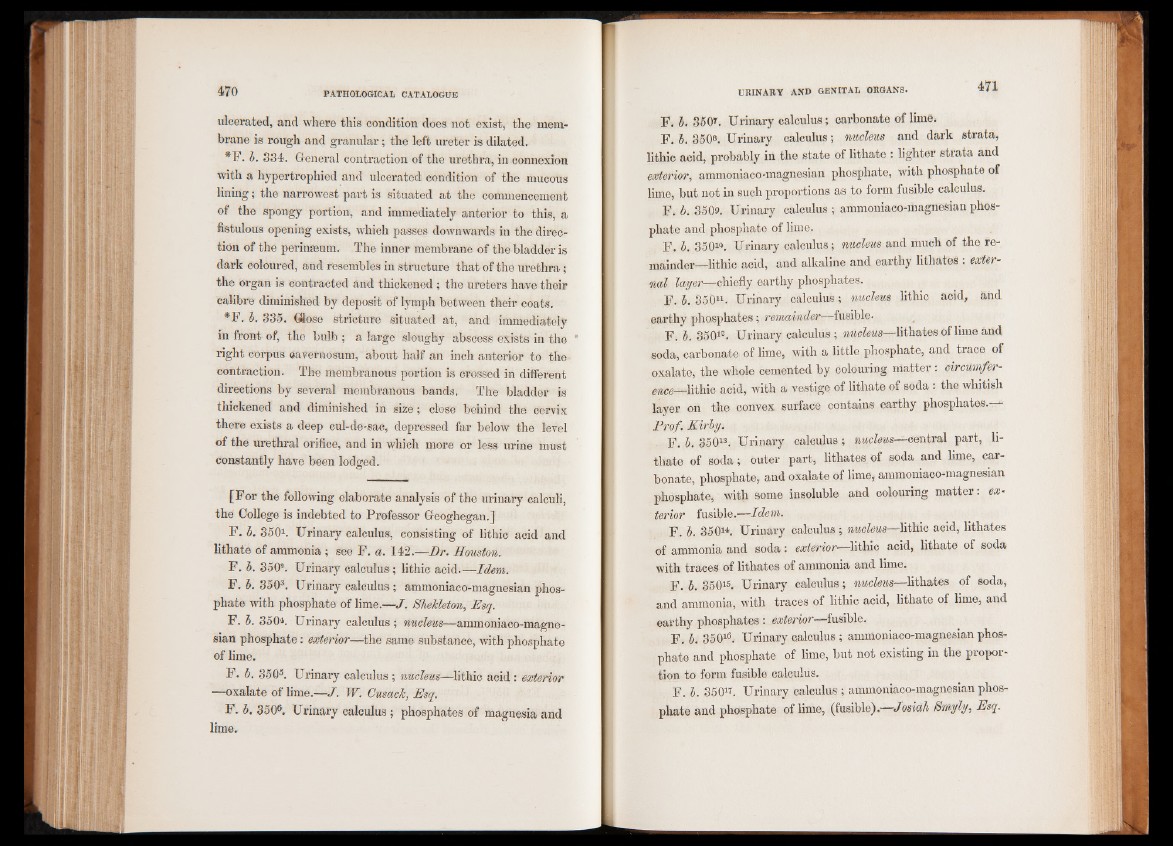
ulcerated, and where this condition does not exist, the membrane
is rough and granular; the left ureter is dilated.
*F. b. 334. General contraction of the urethra, in connexion
with a hypertrophied and ulcerated condition of the mucous
lining; the narrowest part is situated at the commencement
of the spongy portion, and immediately anterior to this, a
fistulous opening exists, which passes downwards in the direction
of the perineeum. The inner membrane of the bladder is
dark coloured, and resembles in structure that of the urethra ;
the organ is contracted and thickened; the ureters have their
calibre diminished by deposit of lymph between their coats.
*F. b. 335. Giose stricture situated at, and immediately
in front of, the bulb ; a large sloughy abscess exists in the
right corpus eavernosum, about half an inch anterior to the
contraction. The membranous portion is crossed in different
directions by several membranous bands. The bladder is
thickened and diminished in size; close behind the cervix
there exists a deep cul-de-sac, depressed far below the level
of the urethral orifice, and in which more or less urine must
constantly have been lodged.
[For the following elaborate analysis of the urinary calculi,
the College is indebted to Professor Geoghegan.]
F. b. 350b Urinary ealeulus, consisting of lithie acid and
lithate of ammonia; see F. a. 142.—Dr. Houston.
F. b. 350*. Urinary calculus ; lithie acid.—Idem.
F. b. 35 03. Urinary calculus; ammoniaco-magnesian phosphate
with phosphate of lime.—J. Shekleton, Esq.
F. b. 350b Urinary calculus; nucleus—ammoniaco-magnesian
phosphate: exterior—the same substance, with phosphate
of lime.
F. b. 35Q5. Urinary calculus; nucleus—lithie acid: exterior
—oxalate of lime.—J. W. GusacJc, Esq.
F. b. 3506. Urinary calculus; phosphates of magnesia and
lime.
F. b. 350b Urinary calculus; carbonate of lime.
F. b. 350e. Urinary calculus; nucleus and dark strata,
lithie acid, probably in the state of lithate : lighter strata and
exterior, ammoniaco-magnesian phosphate, with phosphate of
lime, but not in such proportions as to form fusible calculus.
F. b. 3509. Urinary calculus ; ammoniaco-magnesian phosphate
and phosphate of lime.
F. b. 3501Q. Urinary calculus ; nucleus and much of the remainder—
lithie acid, and alkaline and earthy Iithates ; external
layer—chiefly earthy phosphates.
F. b. 35011. Urinary calculus ; nucleus lithie acid, and
earthy phosphates ; remainder—fusible.
F. b. 35 013. Urinary calculus ; nucleus—Iithates of lime and
soda, carbonate of lime, with a little phosphate, and trace of
oxalate, the whole cemented by colouring matter : circumference—
lithie acid, with a vestige of lithate of soda : the whitish
layer on the convex surface contains earthy phosphates.—
PrFof.. Kirbb. y3.5013. Urinary calculus ; nucleus—central part, lithate
of soda ; outer part, Iithates of soda and lime, carbonate,
phosphate, and oxalate of lime, ammoniaco-magnesian
phosphate, with some insoluble and colouring matter : exterior
fusible.—Idem.
F. b. 350U. Urinary calculus ; nucleus—lithie acid, Iithates
of ammonia and soda : exterior—lithie acid, lithate of soda
with traces of Iithates of ammonia and lime.
F. b. 350lS. Urinary calculus ; nucleus—Iithates of soda,
and ammonia, with traces of lithie acid, lithate of lime, and
earthy phosphates : exterior—fusible.
F. b. 35016. Urinary calculus ; ammoniaco-magnesian phosphate
and phosphate of lime, but not existing in the proportion
to form fusible calculus.
F. 5. 3503b Urinary calculus ; ammoniaco-magnesian phosphate
and phosphate of lime, (fusible).—Josiah Bmyly, Esq.